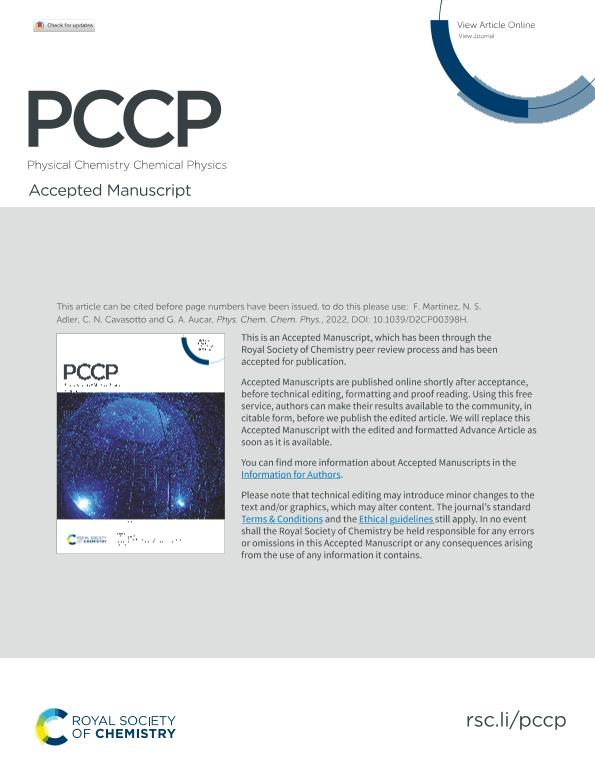Mostrar el registro sencillo del ítem
dc.contributor.author
Martínez, Fernando Ariel

dc.contributor.author
Adler, Natalia Sol

dc.contributor.author
Cavasotto, Claudio Norberto

dc.contributor.author
Aucar, Gustavo Adolfo

dc.date.available
2023-10-03T15:52:31Z
dc.date.issued
2022-07
dc.identifier.citation
Martínez, Fernando Ariel; Adler, Natalia Sol; Cavasotto, Claudio Norberto; Aucar, Gustavo Adolfo; Solvent effects on the NMR shieldings of stacked DNA base pairs; Royal Society of Chemistry; Physical Chemistry Chemical Physics; 24; 30; 7-2022; 18150-18160
dc.identifier.issn
1463-9076
dc.identifier.uri
http://hdl.handle.net/11336/213969
dc.description.abstract
Stacking effects are among the most important effects in DNA. We have recently studied their influence in fragments of DNA through the analysis of NMR magnetic shieldings, firstly in vacuo. As a continuation of this line of research we show here the influence of solvent effects on the shieldings through the application of both explicit and implicit models. We found that the explicit solvent model is more appropriate for consideration due to the results matching better in general with experiments, as well as providing clear knowledge of the electronic origin of the value of the shieldings. Our study is grounded on a recently developed theoretical model of our own, by which we are able to learn about the magnetic effects of given fragments of DNA molecules on selected base pairs. We use the shieldings of the atoms of a central base pair (guanine-cytosine) of a selected fragment of DNA molecules as descriptors of physical effects, like π-stacking and solvent effects. They can be taken separately and altogether. The effect of π-stacking is introduced through the addition of some pairs above and below of the central base pair, and now, the solvent effect is considered including a network of water molecules that consist of two solvation layers, which were fixed in the calculations performed in all fragments. We show that the solvent effects enhance the stacking effects on the magnetic shieldings of atoms that belong to the external N-H bonds. The net effect is of deshielding on both atoms. There is also a deshielding effect on the carbon atoms that belong to C 00000000 00000000 00000000 00000000 11111111 00000000 11111111 00000000 00000000 00000000 O bonds, for which the oxygen atom has an explicit hydrogen bond (HB) with a solvent water molecule. Solvent effects are found to be no higher than a few percent of the total value of the shieldings (between 1% and 5%) for most atoms, although there are few for which such an effect can be higher. There is one nitrogen atom, the acceptor of the HB between guanine and cytosine, that is more highly shielded (around 15 ppm or 10%) when the explicit solvent is considered. In a similar manner, the most external nitrogen atom of cytosine and the hydrogen atom that is bonded to it are highly deshielded (around 10 ppm for nitrogen and around 3 ppm for hydrogen).
dc.format
application/pdf
dc.language.iso
eng
dc.publisher
Royal Society of Chemistry

dc.rights
info:eu-repo/semantics/openAccess
dc.rights.uri
https://creativecommons.org/licenses/by-nc-sa/2.5/ar/
dc.subject
Efectos de solvente
dc.subject
RMN
dc.subject
Apantallamientos
dc.subject.classification
Física Atómica, Molecular y Química

dc.subject.classification
Ciencias Físicas

dc.subject.classification
CIENCIAS NATURALES Y EXACTAS

dc.title
Solvent effects on the NMR shieldings of stacked DNA base pairs
dc.type
info:eu-repo/semantics/article
dc.type
info:ar-repo/semantics/artículo
dc.type
info:eu-repo/semantics/publishedVersion
dc.date.updated
2023-07-07T18:10:15Z
dc.journal.volume
24
dc.journal.number
30
dc.journal.pagination
18150-18160
dc.journal.pais
Reino Unido

dc.journal.ciudad
Cambridge
dc.description.fil
Fil: Martínez, Fernando Ariel. Consejo Nacional de Investigaciones Científicas y Técnicas. Centro Científico Tecnológico Conicet - Nordeste. Instituto de Modelado e Innovación Tecnológica. Universidad Nacional del Nordeste. Facultad de Ciencias Exactas Naturales y Agrimensura. Instituto de Modelado e Innovación Tecnológica; Argentina
dc.description.fil
Fil: Adler, Natalia Sol. Consejo Nacional de Investigaciones Científicas y Técnicas. Centro Científico Tecnológico Conicet - Nordeste. Instituto de Modelado e Innovación Tecnológica. Universidad Nacional del Nordeste. Facultad de Ciencias Exactas Naturales y Agrimensura. Instituto de Modelado e Innovación Tecnológica; Argentina. Consejo Nacional de Investigaciones Científicas y Técnicas. Oficina de Coordinación Administrativa Parque Centenario. Centro de Investigaciones en Bionanociencias "Elizabeth Jares Erijman"; Argentina
dc.description.fil
Fil: Cavasotto, Claudio Norberto. Consejo Nacional de Investigaciones Científicas y Técnicas. Centro Científico Tecnológico Conicet - Nordeste. Instituto de Modelado e Innovación Tecnológica. Universidad Nacional del Nordeste. Facultad de Ciencias Exactas Naturales y Agrimensura. Instituto de Modelado e Innovación Tecnológica; Argentina. Universidad Austral; Argentina
dc.description.fil
Fil: Aucar, Gustavo Adolfo. Consejo Nacional de Investigaciones Científicas y Técnicas. Centro Científico Tecnológico Conicet - Nordeste. Instituto de Modelado e Innovación Tecnológica. Universidad Nacional del Nordeste. Facultad de Ciencias Exactas Naturales y Agrimensura. Instituto de Modelado e Innovación Tecnológica; Argentina. Universidad Nacional del Nordeste; Argentina
dc.journal.title
Physical Chemistry Chemical Physics

dc.relation.alternativeid
info:eu-repo/semantics/altIdentifier/url/https://pubs.rsc.org/en/content/articlelanding/2022/cp/d2cp00398h
dc.relation.alternativeid
info:eu-repo/semantics/altIdentifier/doi/https://doi.org/10.1039/D2CP00398H
Archivos asociados
